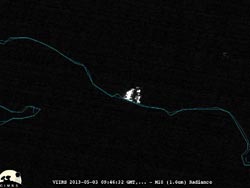Satellite Captures Night-time image of California’s Springs Fire

<br>
The Suomi NPP satellite carries an instrument so sensitive to low light levels that it can detect wildfires in the middle of the night.
The Day/Night band on Suomi/NPP produces Night-Time visible imagery using illumination from natural (the moon, forest fires) and man-made sources (city lights, gas flares).
On May 3 and 4, 2013, the Visible Infrared Imaging Radiometer Suite (VIIRS) on Suomi-NPP acquired animated images of the Springs Fire blazing near Los Angeles, California. The animation clearly shows the fire as a bright white circular area on May 3 near Point Mugu State Park.
As the light of the fire traveled through the smoke, it got scattered (like shining a flashlight through smoke) appears brighter on the satellite image. The bright spot disappeared on May 4 as the blaze was coming under control as a result of firefighting efforts. The animation was created with data from the instrument’s “day-night band,” which sensed the fire in the visible portion of the spectrum.
According to Reuters news on May 6, the Springs Fire consumed as much as 28,000 acres of brush in the coastal area located northwest of Los Angeles. The fire started on Thursday, May 2, and by Sunday, May 5, the weather allowed firefighters to put containment lines around the fire.
Image Credit: William Straka III, University of Wisconsin, CIMSS
Text Credit: Rob Gutro, NASA’s Goddard Space Flight Center
Media Contact
All latest news from the category: Earth Sciences
Earth Sciences (also referred to as Geosciences), which deals with basic issues surrounding our planet, plays a vital role in the area of energy and raw materials supply.
Earth Sciences comprises subjects such as geology, geography, geological informatics, paleontology, mineralogy, petrography, crystallography, geophysics, geodesy, glaciology, cartography, photogrammetry, meteorology and seismology, early-warning systems, earthquake research and polar research.
Newest articles

Superradiant atoms could push the boundaries of how precisely time can be measured
Superradiant atoms can help us measure time more precisely than ever. In a new study, researchers from the University of Copenhagen present a new method for measuring the time interval,…

Ion thermoelectric conversion devices for near room temperature
The electrode sheet of the thermoelectric device consists of ionic hydrogel, which is sandwiched between the electrodes to form, and the Prussian blue on the electrode undergoes a redox reaction…

Zap Energy achieves 37-million-degree temperatures in a compact device
New publication reports record electron temperatures for a small-scale, sheared-flow-stabilized Z-pinch fusion device. In the nine decades since humans first produced fusion reactions, only a few fusion technologies have demonstrated…





















